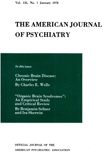PSYCHOSOMATIC DERMATOLOGICAL SYNDROMES IN MILITARY SERVICE
Abstract
1. Psychosomatic dermatological syndromes (neurodermatitis, psychogenic urticaria, pruritus and hyperhidrosis) should be excluded from induction just as much as chronic asthma, peptic ulcer, functional hypertension, and chronic psychoneurosis whether expressed purely in psychological symptoms or as other psychosomatic syndromes.
2. Psychosomatic dermatological syndromes are produced or aggravated by the environmental stress of military service.
3. Predisposition is a common and important characteristic.
4. In predisposed individuals faced with situations which are frustrating, potentially threatening or distasteful, an initial attack or new attack or aggravation of a psychosomatic dermatological syndrome can be expected. Specific examples of such situations are rebellion against authority, distasteful duty assignment, and return to combat.
5. Prognosis is poor as far as continued military service is concerned, even on limited duty. These patients react like chronic asthmatics, having recurrent disabling attacks under even minimal environmental stress.
Access content
To read the fulltext, please use one of the options below to sign in or purchase access.- Personal login
- Institutional Login
- Sign in via OpenAthens
- Register for access
-
Please login/register if you wish to pair your device and check access availability.
Not a subscriber?
PsychiatryOnline subscription options offer access to the DSM-5 library, books, journals, CME, and patient resources. This all-in-one virtual library provides psychiatrists and mental health professionals with key resources for diagnosis, treatment, research, and professional development.
Need more help? PsychiatryOnline Customer Service may be reached by emailing [email protected] or by calling 800-368-5777 (in the U.S.) or 703-907-7322 (outside the U.S.).



